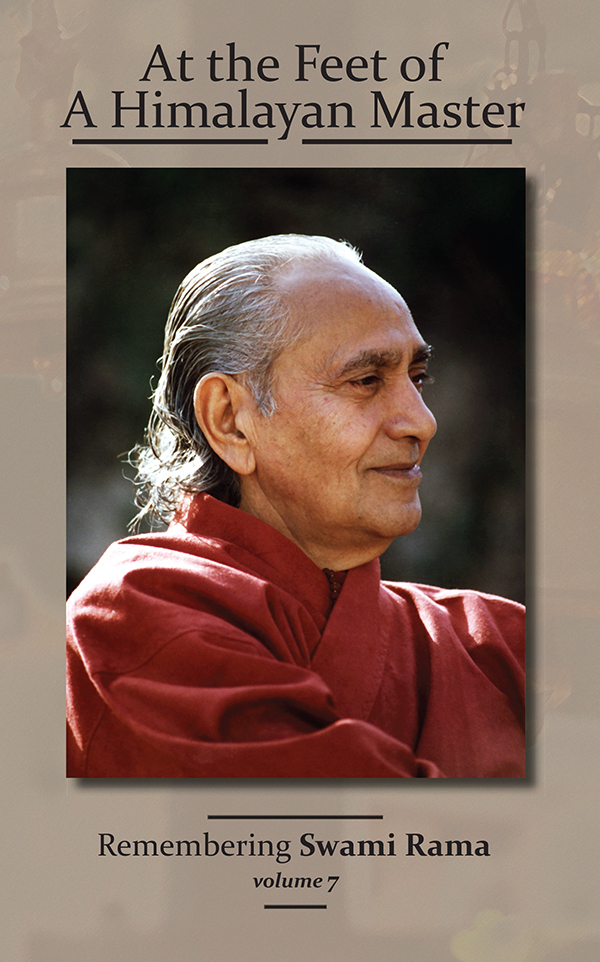Preface
This is volume 7 of the series At the Feet of a Himalayan Master and includes the reminiscences of nine disciples of Swami Rama, six women and three men, four living in the U.S., one from the U.K. and four from India. This takes the total number of contributors to the series to 34 disciples who have generously shared their inspiring experiences they had with the master.
Nina Johnson was asked by Swami Rama to start The Yoga Society of Milwaukee when he gave her mantra initiation. She was reluctant because of her family responsibilities but Swamiji would not take “no” for an answer and The Yoga Society of Milwaukee was founded with Nina Johnson as its Director. An important lesson that Nina learnt from this experience was to always do as the guru directed. As a result, she was successful as a yoga teacher and administrator. She completed her family responsibilities and was able to retire to the mountains of the Himalayas in Malethi, Uttarakhand. Here, she has devoted her life to one of meditation and contemplation and continually enjoys the guru’s presence.
William Sparacia, a hair dresser and hair salon owner, came to Swamiji’s Rishikesh ashram to deliver a gift to Swamiji from a disciple in Lanzarote, Spain. He ended up having Swamiji arrange his wedding to Karen, his girlfriend. He became a part of the family of the disciples of the tradition and began his annual visits to the Himalayan Institute Hospital Trust campus in Jolly Grant. Swamiji, unobtrusively, provided direction in Willie’s life, who even today, is discovering how masterly the guru’s touch is. He manages several hair salons in three countries and has created innovative hair care products marketed in several international markets.
Maya Tandon was only 10 years old when Swami Rama knocked on her father’s door, late one night, in Kanpur, India. At that time he had all the trappings of a dandi swami, the ochre robes, danda (staff) and stringent regulations pertaining to food, speech, company he kept, etc. He had studied at the Allahabad University with Maya’s father and came to renew that friendship after many intervening years. Maya was fascinated by the imposing personality of Swami Rama, his ability to know her mind and heart and his love and compassion. Swamiji arranged Maya’s wedding to one of his devoted disciples, Shivnath Tandon. He arranged a job for Shivnath in the U.S. and continued to mentor and guide Maya, Shivnath and their family for almost four decades. His love and caring was abundant and he looked after their material and spiritual welfare with frequent phone calls, visits to their Minneapolis home and arranging for their trips to his centers in Chicago and Honesdale.
Dr. Seethalakshmi was first spotted by Swami Rama at an international yoga conference near Bangalore, India, where she was part of the organizing team and he was the keynote speaker. For the three days of the conference, she kept running into him, with him telling her that she had to come and be a part of his hospital mission. She told him that she was a pharmacologist not a clinician, but he made her a part of his organizing team for establishing the medical college and hospital at Jolly Grant, Uttarakhand, India, utilizing her skills in medical education and administration. He later invited her to his Rishikesh ashram for mantra initiation and spiritual guidance. He shocked her by telling her that she had been his disciple for three previous lifetimes, and that in this fourth lifetime, with his guidance, she had to make the necessary efforts for self-realization. Dr. Seethalakshmi continues to visit the HIHT campus and has served the organization in various advisory capacities.
Dr. Sunil Saini is an oncology surgeon and Director of the Cancer Research Institute at Swamiji’s Himalayan Institute Hospital Trust (HIHT). He has utilized the opportunity of penning his reminiscences of Swami Rama to deeply introspect about his childhood influences, his professional training and his family relationships. He delineates how Swami Rama cleared the cobwebs of his mind, helped him balance his idealism with practical worldly realities and deepened his understanding of health, disease and healing at the much deeper level of body, breath, mind and spirit integration. He was able to do this without having to compromise his devotion to science and rational thinking and his lack of belief in religious rituals and supernormal phenomena.
Mrs. Sailaja is also a member of the HIHT family in administration who came to the campus in 1993, from faraway Andhra Pradesh in South India, looking for a job as a clerk/typist/stenographer. She left her home because of family disapproval of her choice of a life partner. Sailaja was proud of having qualified for the job because of her excellent credentials, till she learnt that Swamiji had seen her entering the office of the administrator and had sent word that she be hired right away. Swamiji made her one of his office assistants and later made her a coordinator. She was shocked when he once addressed her by a pet name known only to her close family members, giving away the fact that he knew her from previous times. Sailaja went through the three testing phases of most disciples: inordinate praise, severe reprimands and being ignored (along with temporary banishment from Swamiji’s office), till she learnt to trust the guru and accept his directions. She continues to live on the HIHT campus and loyally serves Swamiji’s mission.
Mrs. Savithri Reddy was first introduced to Swami Rama through a newspaper review of his book Living with the Himalayan Masters. She was eager to get hold of the book, read it several times, and wrote to her close friends living in the U.S. about the book and Swami Rama. They were impressed, visited Honesdale, Pennsylvania and got to know and revere Swamiji. When Savithri’s husband was killed in an automobile accident, Savithri sank into a deep depression, devasted by the untimely death of her husband. Her friends in the U.S. arranged for Savithri to come to Swamiji’s ashram in Rishikesh during one of his visits to India. Swamiji gave Savithri a lot of love and attention taking her for walks along the sacred Ganges flowing beside the ashram. Savithri was lifted out of her despondency and wanted to stay on in Rishikesh and help Swamiji manage the ashram. Family problems intervened and this did not happen. Swamiji visited Bangalore and stayed with her, drawing her family members into his loving ambit. Savithri continued to stay connected with Swamiji’s mission and received his loving attention.
Kishi Malhotra’s father returned from a U.S. trip in early 1986 and brought back with him a book titled Living with the Himalayan Masters by Swami Rama. Though Kishi was an indifferent student, not interested in books, he read this book in its entirety, without awareness of the passage of time. Kishi’s father, an educationist and administrator, became involved in Swamiji’s hospital mission and Kishi had several opportunities to experience Swamiji’s love. With Swamiji’s grace, he stopped partying and drinking, improved in his studies and successfully completed his bachelor’s degree. Swamiji then facilitated his post graduate education at Syracuse University in the U.S. Throughout his U.S. studies, all his expenses of tuition, books, boarding, lodging and other personal expenses were completely taken care of by Swamiji and he spent many vacations at Swamiji’s Institute in Pennsylvania, basking in his love. Kishi’s emotional nature found great fulfillment in Swamiji’s presence and loving hugs. Swamiji arranged Kishi’s marriage to Manisha, the daughter of one of his Kanpur disciples. Kishi was reluctant to get married at that stage of his life but could not refuse in the face of Swamiji’s overwhelming love and caring guidance. Kishi was able to receive Swamiji’s loving touch just before Swamiji dropped his body in November 1996. He was devastated, but comforted by his rakhi sister Kamal Didi (Patrice Hafford) who reminded him that Swamiji was still around, just not visible to human eyes. Kishi has had a successful professional career in the U.S. with companies like Microsoft and Facebook, has raised a loving family, and continues to experience Swamiji’s grace.
Ileana De Geyndt was born in Mexico and her early spiritual development was nurtured by her father. At the age of 12, she had viral encephalitis and she credits Swami Rama with saving her life and protecting her from brain damage. She married Willy De Geyndt from Belgium and the family settled for a little more than a decade in Minnesota, where she came in contact with the Meditation Center in Minneapolis and yoga teachers like Dr. Arya (later Swami Veda Bharati) and Yogi Achala. She studied hatha yoga, meditation, the Yoga Sutras and other teachings of the Himalayan tradition. She finally met Swami Rama in 1972 and his palpable influence created a lot of churning and cleansing of her mind and life. Initially, Swami Rama urged her to stay faithful to her husband Willy inspite of his infidelity, but when he had strayed once too often, Swamiji ordered her to end the relationship and helped her in many subtle ways to gather the evidence needed for separation. Ileana was fortunate to be in India when Swami Rama dropped his body. At the bhandara following Swamiji’s mahasamadhi, she had a beautiful encounter with a young, jovial, radiant yogi whom she later identified with Swami Rama by the way he spoke to her and related to her. Swami Rama taught Ileana how to live life to the fullest without losing sight of the meaning and purpose of life. Ileana has shared the teachings of the Himalayan tradition by teaching in several countries and establishing two yoga studios.
As with previous volumes of this series, readers will discover the many dimensions of Swami Rama. The authors of this volume are from diverse backgrounds: geographic, cultural, economic, religious, professional, etc. Despite these differences, they were drawn by Swamiji’s compassion, love and caring mentorship. He could be a tough taskmaster, but knowing that this was also a manifestation of his love, disciples were not discouraged or driven away, but continued to work on their shortcomings. It is now more than two decades since Swamiji dropped his mortal coil, but his love, guidance and presence continue to instruct and inspire. May the younger generation of spiritual seekers who were born after Swamiji’s mortal demise, find inspiration in these volumes and learn to discover the divinity that dwells within them.

